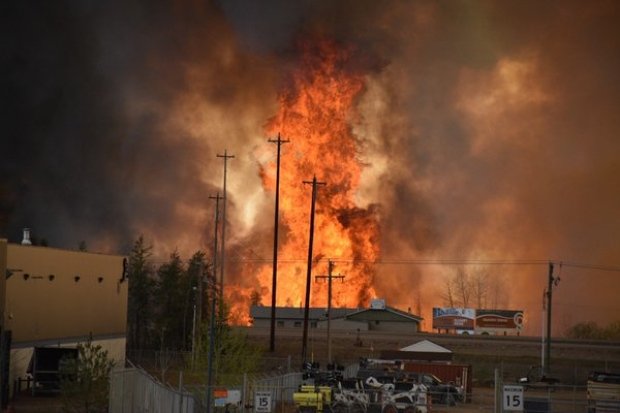Some 8,000 people who fled north of Fort McMurray have been airlifted by authorities as blaze engulfed the Canadian city.
Fort McMurray has been devastated by a massive wildfire.
Officials also hope that the only highway to the south will become safe on May 6 to move the remaining 17,000 people, who are in danger of becoming trapped.
The entire city of Fort McMurray – more than 88,000 people – was evacuated three days ago. Most fled south but some went north.
The fire in the province of Alberta has grown to 328.2 sq miles.
Hundreds of firefighters are battling the blaze using helicopters and air tankers.

The fire, which covers an area almost the size of Calgary, Alberta’s largest city, has slowed down and is now heading away from Fort McMurray.
Alberta Premier Rachel Notley warned city residents that they were facing a long wait before they would be able to return home.
The blaze has already destroyed more than 1,600 homes and other buildings in Fort McMurray.
A rare province-wide fire ban has been declared to try to reduce risk of further blazes.
Most of those who fled north have been staying in oil sands work camps in the remote area.
About 4,000 of them have already been flown in military and civilian transport planes to Edmonton and Calgary and another 4,000 are expected to be rescued within hours.
The authorities hope that Highway 63, passing through Fort McMurray, will be safe on May 6 to move the rest. A helicopter is expected to lead that evacuation convoy.
The evacuees are being moved again because urban areas in the south are better able to support the displaced, officials say.
“Our focus right now is on getting those people south as quickly as possible,” Rachel Notley said.
“I must be very, very direct about this – it is apparent that the damage to the community of Fort McMurray is extensive and the city is not safe for residents.”
On the prospect of returning to the city Premier Rachel Notley said: “Unfortunately, we do know that it will not be a matter of days.”
The fire is growing in size due to high winds but it is “under control”, officials say.
It started on May 1 in Canada’s oil sands region and many oil sands projects have cut production.
Some people were forced to flee twice: first to temporary refuges south of Fort McMurray then again as the flames grew.
The government is working on finding temporary housing for families who lost their homes and belongings in the blaze.
There are still no known casualties from the fire but there was at least one vehicle crash with fatalities on the evacuation route.
Scott Long of the Alberta Emergency Management Agency called the blaze “an extreme fire event” and said that rain would be needed to fight it.
Cooler temperatures and rain are forecast, giving hope that it could become easier to contain the fire.
